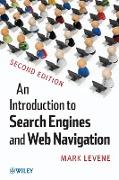- Start
- An Introduction to Search Engines and Web Navigation
An Introduction to Search Engines and Web Navigation
Angebote / Angebote:
An authoritative, easy-to-follow primer on the underlying computational tools of Web search and navigation
Search and navigation technologies are central to the smooth operation of the Web, and have changed the way we seek out and interact with information. Understanding the computational basis of these technologies and the models underlying them is of paramount importance to both computing students and practitioners.
This Second Edition contains up-to-date, unrivalled coverage, bridging the gap between technically based and sociologically oriented Web books. It demystifies the tools that we use when interacting with the Web, as well as models different aspects of the Web that can help us understand how it is evolving--and how it is being, and can be, effectively used.
The first part of the book covers the historical background of hypertext, the Web, and search engines and introduces the problems of search and navigation, discussing the potential of machine learning to improve search and navigation tools and proposing Markov chains as a model for user navigation. The second part explains the architectural and technical aspects of search engines. Described here are the search engine wars, the architecture of a search engine and details of how the Web is crawled, a search engine's ranking algorithm, and different ways of evaluating search engines. Then, different types of search engines are explored, including Web directories, search engine advertising, metasearch engines, personalization of search, question-answering engines, image search, and special purpose engines. The final part concentrates on Web navigation, the mobile Web, and social network technologies in the context of search and navigation. Discussed are a range of navigation tools and metrics, Web data mining and visualization of Web navigation, the issues present in real-world navigation, the delivery of mobile Web services and the problems of search and navigation in a mobile context, peer-to-peer networks, the technology of collaborative filtering, Weblogs as a medium for personal journalism, social tagging and bookmarking, opinion mining, Web 2.0, and collective intelligence.
Each chapter begins with objectives and concludes with a summary and several exercises. Many real-world technology examples are provided throughout, including social networking, data mining, and nontraditional search engines. This book is intended as an undergraduate introductory text on search and navigation technologies. It is also ideal for IT professionals who wish to understand how these technologies work and what the future holds.
Folgt in ca. 15 Arbeitstagen




